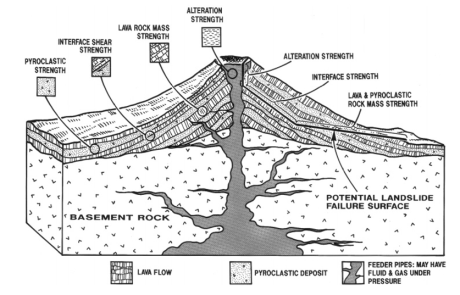Volcanoes are inherently unstable
This is due to the piling higher and higher of different types of deposits, much of which is loose material. This material can only remain stable for so long: the volcano will eventually reach its angle of repose.

The internal structure of a typical composite volcano: alternating layers of lava and pyroclastic layers with different strengths (McGuire, 1996)
Collapses are more likely to happen at steep stratovolcanoes that have slope angles between 28° and 34°, however collapses have occurred on slopes as shallow as 8-10°. Slope angle of volcanoes associated with major flank failure in the last 2.6 million years are shown below.

Slope angle of volcanoes associated with major flank failure in the last 2.6 million years (Voight,B. and Elsworth,D., 1997)
To analyze how stable a slope is, scientists can look at two basic components of the material: 1) Friction angle- angle of internal shearing resistance (phi) expressed in degrees, and 2) Cohesion- attraction of one grain of material. Together, these components make up the shear strength of the slope, which explains how well the slope can resist failure.
